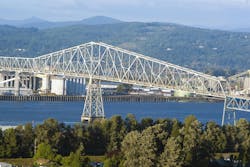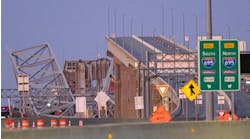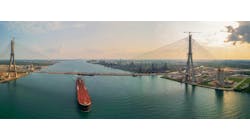Bridges across the United States lack shields that could block ships from crashing into them. At 309 major bridges on navigable waterways in the country, inspections have found protection systems around bridge foundations that were deteriorating, outdated, or nonexistent, leaving the structures exposed to ship strikes, according to a report by The New York Times.
The Lewis and Clark Bridge, which connects Washington and Oregon, is one such bridge. Decades ago, it had timber shields that have since rotted away, making the structure more vulnerable to disaster. The states view the risk of calamity as low and the cost of preventing it to be high.
Washington Department of Transportation officials have said they will watch the Baltimore investigation to determine whether new pier protections on the Lewis and Clark Bridge might be needed. But Kelly Hanahan, a WDOT spokeswoman, cautioned that the state has limited funds.
“This would be an improvement project that would cost tens of millions of dollars,” she said.
According to The New York Times analysis, there are dozens of vulnerable bridges spanning waterways that are corridors for large vessels. The analysis saw 193 bridges that have no protection installed.
In the wake of the Francis Scott Key Bridge collapse, this analysis shows that bridges have suffered similar catastrophic failures in recent decades.
Some states have focused less on upgrading their bridges and instead are working on plans to evacuate them quickly in the event of a ship strike or other incident. Some are concentrating on improving navigation and tugboat protocols to lessen the likelihood of collisions. Some are doing nothing.
The Crescent City Connection in New Orleans is a two-span bridge, with one built in 1958 and the other in 1988. Both were completed before the adoption of more modern standards.
A pair of private engineering researchers started looking at the bridge and two others nearby in the 1990s after a series of vessel accidents. In findings published for their peers, they found that the protection systems around the bridges “do not have the strength and energy absorption capacity to affect the consequences of major vessel collisions,” and that the bridges’ foundations might not survive a head-on collision.
The New York Times’ analysis found bridges with similar flaws, such as the Dolphin Expressway in Florida. The bridge supports are protected by a deteriorating system. Luckily, the transportation agency managing the bridge said it is working to replace the protection system.
In 2015, a 600-foot freighter lost propulsion in the Delaware River, but averted disaster by crashing into the riverbed instead of the Burlington-Bristol Bridge that connects Pennsylvania to New Jersey. This bridge is one of several along the waterway where inspectors found deteriorated protection systems around the bridge piers.
However, down the river at the Delaware Memorial Bridge, crews are building a protection system for the $93 million project.
The Tobin Bridge in Massachusetts has no protection system for its piers.
Jonathan Gulliver, the highway administrator at the Massachusetts Department of Transportation, said he is confident that the navigation protocols imposed on ships operating in the area, including tugboat escorts for large vessels, can assure safe operations. But in the aftermath of the Baltimore disaster, he said, his agency’s engineers are re-evaluating the potential risks.
Other bridges are also getting some consideration to install protection, such as the Commodore Barry Bridge outside of Philadelphia.
The Tobin Bridge and the Commodore Barry Bridge each have “fracture critical” designs, meaning that the failure of a key component would probably cause a wider collapse of the span. The analysis found that about half of the major bridges with deficient pier protections were also fracture critical. But bridge design engineers note that the collapse of a pier would be sufficient to take out almost any bridge.
A barge drifted off course on the Arkansas River and rammed into a highway bridge near Sallisaw, Okla. The bridge survived in part to a more robust pier design that made the structure capable of handling a collision. However, in 2002, just up the river, freight barges struck a pier supporting Interstate 40, knocking a section into the river and killing 14 people.
Inland routes such as the Arkansas River, the Missouri River, and the Mississippi River regularly carry barges large enough to take out a bridge.
Many of the bridges on these large inland waterways do not have protection systems, inspectors have found, including the Sherman Minton Bridge that connects Indiana and Kentucky, the Memphis-Arkansas Bridge in Tennessee, and the Robert C. Byrd Bridge linking West Virginia and Ohio.
Even on bridges deemed to have functioning protection systems, it is unclear if the protections are sufficient — an example being the Chesapeake Bay Bridge in Maryland.
The bridge is “not protected the way it should be,” said Vijaya Gopu, a civil engineering professor at the University of Louisiana at Lafayette.
“Maybe it’s protected in a very trivial fashion like the Key Bridge, but I didn’t realize it does not have a robust protection system like dolphins or some rock island,” he said. “That’s something they have to do right away.”
The Maryland Department of Transportation said it was “evaluating potential short-term and long-term mitigation strategies” for the Bay Bridge. The department also said it would “strongly consider” any recommendations from the National Transportation Safety Board’s investigation in Baltimore.
----------------------------------------
Source: The New York Times



